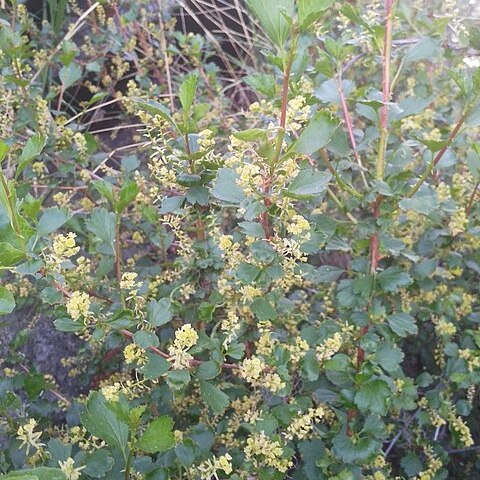Plants dioecious, 0.5-2 m. Stems erect, stipitate-glandular, without nonglandular hairs; spines at nodes 2, 3-5 mm; prickles on internodes scattered. Leaves: petiole 1-2 cm, glabrous; blade ovate to obovate, 3-lobed, cleft barely 1/8 to midrib, 1.5-3.5 cm, base cuneate to rounded, surfaces glabrous abaxially, strigillose adaxially, lobes rounded, margins deeply serrate, apex obtuse. Inflorescences nodding, 10-15-flowered racemes, staminate 2-3 cm, pistillate 1-2 cm, axis glabrous, glandular, flowers evenly spaced. Pedicels jointed, 2-4 mm, pubescent and stipitate-glandular; bracts lanceolate to ligulate, 4-6 mm, glabrous. Flowers unisexual; hypanthium yellowish green, rotate, 1-1.5 mm, glabrous; sepals not overlapping, erect, greenish, ovate, 1.5-2 mm; petals widely separated, erect, greenish yellow, cuneate-orbiculate, not conspicuously revolute or inrolled, 0.5-1 mm; nectary disc not seen; stamens nearly as long as petals; filaments linear, 0.2-0.5 mm, glabrous; anthers cream, dumbbell-shaped, 0.2 mm, apex with depressed callus, (pollen absent in pistillate flowers); ovary (absent in staminate flowers) glabrous; styles connate almost to stigmas, 0.5 mm, glabrous. Berries palatable, red, globose to globose-ovoid, 5-10 mm, glabrous.
More
Shrubs dioecious, 1-2(-3) m tall. Branchlets slightly angled, glabrous; nodal spines 2, 3-5 mm; internodes unarmed or with sparse, slender prickles. Buds brownish, ovoid, 3-5 mm, glabrous, apex acute. Petiole 1-2 cm, glabrous, rarely sparsely puberulent; leaf blade obovate to rhombic-obovate, 1.5-3.5 × 1-3 cm, glabrous, base cuneate; lobes 3, margin deeply serrate, apex obtuse or acute. Male racemes nodding, 3-6 cm, 10-20-flowered, female ones 1-2.5 cm, 10-15-flowered; rachis and pedicels sparsely shortly glandular hairy; bracts lanceolate to ligulate, 4-6 mm, glabrous, 1-veined. Pedicel 2-4 mm. Calyx yellowish green, glabrous; tube rotate to saucer-shaped, 1-1.5 mm; lobes erect, ovate, rarely elliptic, 1.5-2 mm. Petals cuneate-orbicular, 0.5-1 mm. Stamens subequaling petals. Ovary subglobose, glabrous. Style 2-lobed at apex. Fruit red to reddish black, globose to ovoid-globose, 0.5-0.9 cm in diam., glabrous. Fl. May-Jun, fr. Aug-Sep.
A shrub. It grows 2 m tall. It has small spines. The leaves are 3.5 cm across. They have 3 shallow blunt lobes. The leaves are shiny and have teeth. Flowers are separately male and female. They are greenish-yellow and in erect groups. The fruit are bright red.

